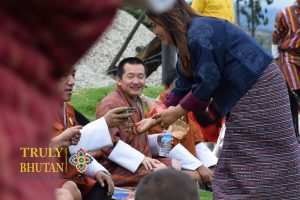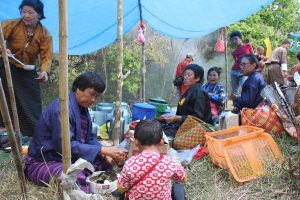Though Bhutan is a small country with moderate development and sparsely populated settlements the landscapes and climate vary dramatically. From basic sub-tropical plains to valleys and steep mountains such as Jomolhari (7326m), the country has perfect locations that offer availability for trekking destinations, camping, rafting, and adventurous trails. (Bhutan Ethnicity)
Similarly, Bhutan has five contrasting seasons: summers, monsoons, autumn, winters, and spring.
In the highland of northern areas such as Lunana, Laya, and Lingzhi, the place has snow for all seasons. Southern Bhutan has hot and humid summers and cool winters; suitable for organic cultivation and rearing livestock. Western Bhutan has heavier monsoon rains with cool winters. Accordingly, October, November, and April to mid-June are the best months for visiting Bhutan and exploring the places.
Bhutanese citizens compromise three different ethnic groups inhabiting the native land.
In eastern Bhutan, the Sharchops (Indo-Mongoloid) group of people resides. They have their way of lifestyle and language and they are believed to be the initial inhabitants of Bhutan. Secondly, the Tibetan descendants, Ngalongs, who migrated to Bhutan in the early 19th century, are inhabitants of western Bhutan.

The third ethnic group is called Lhotshampa which bears Nepalese origin and migrated to Bhutan in the mid-19th century and settled in the foothills of southern Bhutan. Furthermore, there are also some minor ethnic groups in Bhutan like Layap, Brokpa, Doya, Lhopu, Dhakpa, and Lepcha. All of these ethnic groups comfortably accept each other and mirthfully live as proud Bhutanese citizens even if they have their own social beliefs and rare traditions that have been passed down in their tribe for generations.
The Bhutanese are generally religious and compassionate.
They strongly believe in the cycle of karma and the afterlife, where the only way to attain a spiritual journey after death or be reborn as a human is by doing good deeds and practicing dharma in the present life. And hence to accommodate that practice, many temples and monasteries are visibly evident around the country. Many families send off their sons to study religion and live their life serving as religious monks and carrying out rituals in monasteries and homes.

The national language of Bhutan is Dzongkha which is initially the language of the western part of Bhutan. People of the eastern part speak Sharchopkha and people of south Nepali. However, the People of urban areas generally understand and speak fluent English and basic Hindi.
Bhutanese painting can be classified into 3 groups: paintings on statues, murals & banners. One interesting thing about statue painting is that clay statues are painted all over and metal statues are painted only on the face.
